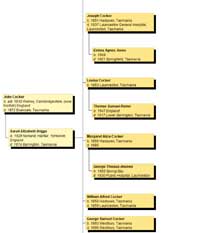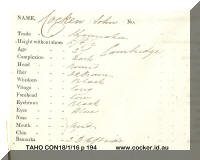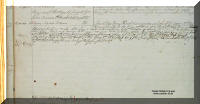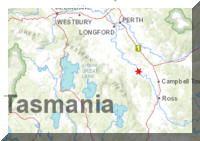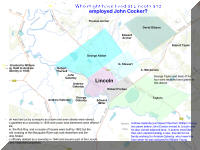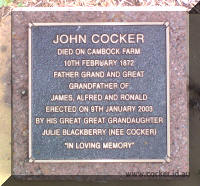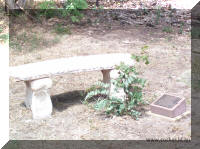John Cocker (1812 - 1872) and Sarah Elizabeth Briggs (1828 - 1874)
John Cocker, son of John Cocker and Margaret Norman, was born in about September 1812 in Welney, Cambridgeshire (now Norfolk) England and was christened on 19 Aug 1813 at the Welney Church of England Chapel, Cambridgeshire. He died on 10 Feb 1872 in Evandale, Tasmania at age 59, and was buried in the Uniting Church Cemetery, Evandale, Tasmania. He served in the 1st Royal Regiment Canada where he was convicted for desertion in 1838 and was transported from England as a convict to Van Diemen’s Land in 1839. He was conditionally pardoned in 1849.
John married Sarah Elizabeth Briggs, daughter of Isaac Briggs and Alice Dean, on 22 Aug 1845 in Green Ponds, now Kempton, Tasmania. Sarah was born on 28 Jul 1828 in Norland, Halifax, Yorkshire, England, was christened on 15 Nov 1831, and died on 30 Aug 1874 in Barrington, Tasmania at age 46. John and Sarah had 11 children:
- John
- Sarah
- Joseph
- Louisa
- Margaret Alice
- William Alfred
- George Samuel
- Albert
- James
- Charles Robert Arthur and
- Jane Evangeline
John Cocker’s Family
John Cocker (Senior), son of John and Ann Cocker married Sarah Watson on 27 May 1805 in Welney, Cambridgeshire. Sarah died some five months after their marriage and was buried at Welney, Cambridgeshire, on 6 Oct 1805. John next married Margaret Norman on 13 Dec 1807 in Welney, Cambridgeshire. Margaret was born about 1790. They had three children: Sarah, Bridget and John. John Senior died on 16 Mar 1826 in Welney at age 40. Read more about Welney here or more about John's family in England here.
John Cocker's Army Career
Private John Cocker (No.863) was enlisted at Glasgow, Scotland on 7 Feb 1832 with the 2nd Batallion,1st Royal Regiment of Foot. Just seven months later, on 27 Jun 1832, he deserted at Glasgow and was recaptured on 21 September 1833. He was court-martialled and sentenced to 2 months hard labour, being released from regimental cells on 14 Nov 1833. In March-June 1834 he had 6 days sick leave whilst in Dublin, Ireland.
In October he was on detachment at Shannon Bridge and was back with the main body of the regiment at Dublin by November. He took 6 days sick leave between 18 October and December 1834 whilst in Dublin and then he deserted again on 18 Dec 1834. He re-joined the regiment from civilian custody on 29 Jan 1835 whilst at Longford, Ireland.
John was sentenced to 6 weeks solitary confinement at a Court Martial held in Athlone, Ireland on 2 Feb 1835 and was marked with the letter "D". From July to September he had a further 9 days sick leave, followed by 8 days in October to December. In January to March 1836 he was sick for 2 days, however he marched with the regiment from Enniskillen to Dublin between 26 March and 2 April 1836.
The 2nd Battalion then went to Lower Canada where it played a role suppressing the infamous Lower Canada Uprising when French Canadian insurgents rebelled against British colonial rule. On 29 June he boarded the vessel from Dublin to Canada- the journey taking 53 days; however time may have been spent in port at Dublin or Montreal. The regiment arrived at Quebec in August 1836 and was based in Montreal but John was on detachment at St Helens in January 1838.
In February 1838 John re-joined the regiment in Montreal but deserted again on 14 Jul 1838 only to be recaptured on 23 July 1838. He was held in confinement and then tried by Court Martial at Montreal, Lower Canada, convicted of desertion from the Royal Regiment and sentenced on 15 August 1838.
The full transcript of his court martial may be read here.
Sentenced to 21 years transportation, John was returned to England. His name appears on a list of military prisoners in the Quebec city gaol awaiting transportation, probably September or October. John was transferred on 30 Nov 1838 to the hulk Leviathan moored at Portsmouth, England. He spent several months on the Leviathan, appearing on the quarterly returns for the last quarter of 1838 and the first quarter of 1839. This suggests he travelled by steam boat from Montreal to Quebec, and was sent onward to England on 2 Nov 1838 aboard the HMS Atholl.
To Van Diemen’s Land
He departed England on 12 Mar 1839 on the Marquis of Hastings. He was a shoemaker aged 25, single, illiterate and with a bad gaoler's report. Three months and 17,000 km later he arrived in Van Diemen's Land. John arrived shortly before the end of the assignment era and he was interviewed by authorities before being disembarked in Hobart Town. As with all convicts they carefully recorded his description in case it was necessary to describe or identify him at a later time.
John Cocker Cambridge
Trade: Shoemaker
Height without shoes: 5 feet 8 and a half
inches
Age: 27
Complexion: Dark
Head: Round
Hair: dark
brown
Whiskers: Black
Visage: Long
Eyebrows: Black
Eyes: Blue
Nose: Medium
Mouth: Medium
Chin: Medium
Remarks: 2 D left side
John was assigned to William Young at Lake River. William Young, wife Rachel and children emigrated to Van Diemen's Land on the City of Edinburgh in 1825. William's younger brother Robert had already taken up a land grant at Beverly where he died in 1826, having arrived with his first cousin Hugh Murray and families. William took up a land grant and settled at Lake River, later known as Pisa, near Cressy. William sold his land to Andrew Gatenby and left Tasmania on 11 Aug 1846. He then took up a lease with Adam Turnbull (who married his daughter Margaret) of the Mt Koroite and Dundas stations, in South-Western Victoria.
John Cocker did not fare well under William Young who had him before a magistrate for misconduct three times.
A profile from the full transcription of John Cocker's convict record is available here.
On 15 Jun 1841 John was sentenced to twenty four lashes for disobedience of orders. On 18 Nov 1841 he was sentence to 14 days solitary confinement for insolence. A year later, on 1 Nov 1842 he was sentenced to 6 months hard labour in chains for misconduct in ill-treating a horse. Further his record was noted “never to be assigned again” and he was sent to work on the Ross Road Gang.
In the first of his two years spent on the Ross Road Gang he was in trouble for minor breaches four times. On 21 Dec 1842 he charged with misconduct, a week later on 29 Dec 1842 he was sentenced to 7 days solitary confinement for refusing to work. On 15 April and 1 May 1843 he was charged with neglect of duty and sentenced to 4 days and 1 day solitary confinement respectively. His conduct record shows us that on 12 Apr 1844 he was a class 2 prisoner but only five months later he was granted Class 3 status which means his conduct had been excellent, his leg irons were removed and he worked in a road party, no longer a chain gang.
Despite his record being endorsed “never to be assigned again” John was rewarded for his 18 months good behaviour by being ‘assigned’ to Benjamin Briggs at Brighton. On 7 Dec 1844 the Hobart Town Gazette reported that the Lieutenant-Governor had sanctioned a number of engagements of Pass-holders in private service. They included John Cocker, M. of Hastings 1, to Benjamin Briggs, Bagdad, for 6 months from 11th November.
Which is presumably how he met Benjamin's niece, Sarah Elizabeth Briggs. On 27 Jul 1845 he applied to marry Sarah Briggs and this application was approved.
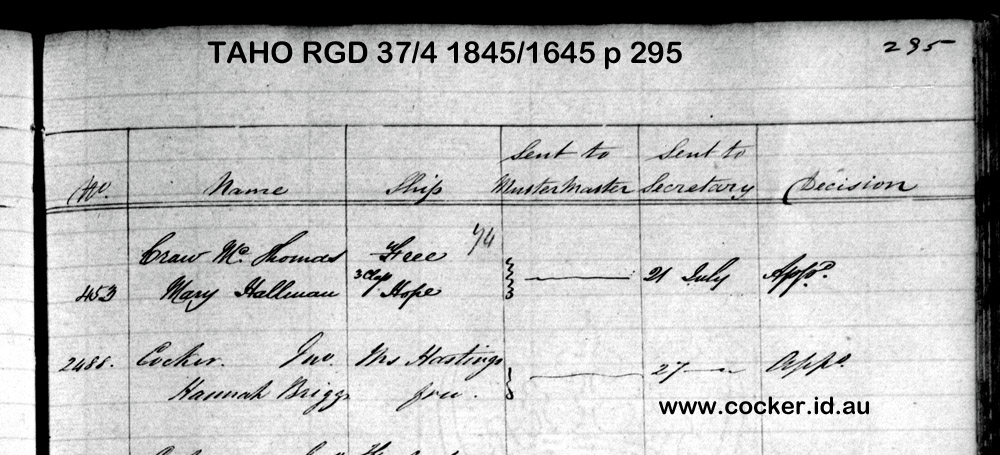
In fact, as the extract of the register above shows, her name was incorrectly recorded as Hannah Briggs. Marriage records (below) show that John Cocker aged 33 years, shoemaker married Sarah Briggs aged 17, spinster at the Church of England at Green Ponds (now Kempton) on 22 Aug 1845.

John Cocker was to have one final and rather curious brush with the law before receiving his Ticket of Leave in 1846. On 4 Oct 1845, some two months after his marriage, he was sentenced to three days solitary confinement for misconduct while assigned to Benjamin Briggs.
That may well have resulted in some interesting conversations in the Cocker and Briggs households. How did Sarah Cocker react to her uncle being responsible for her newly-wed husband spending three nights in gaol; the uncle with whom she had lived and whose children she had helped raise on the death of Benjamin’s wife, Lydey. Perhaps she had hard words with her husband. We may never know. But, only four months later John was granted a ticket of leave, on 10 Feb 1846, and he was thereafter known as a hard working family man. Their first child, John, was born at Brighton on 22 May 1846.
Was he a bad man?
It is possible that John Cocker was a coward, a deserter, a man who could not be trusted or relied upon by his fellow soldiers. That is certainly possible but it is a lazy conclusion because there is another explanation which seems to fit the available facts a little better.
John was a shoemaker from the sleepy little village of Welney in East Anglia, North Eastern England. He was single and in 1831, aged 19, he was a witness at his sister Sarah’s wedding in Welney to George Summers. Why then, less than one year later, did he join a hard core Scottish army regiment in Glasgow? Upon reflection the most likely explanation is that he was press-ganged, tricked or forcibly enlisted against his will. The Battalion had only recently returned to Scotland after an extended period of overseas service and was no doubt rebuilding its strength and numbers.
John first attempted to flee in Glasgow before even seeing active service. That indicates how much he hated the Scottish regiment he found himself in. So, why did he join it? His second attempt to flee was in Ireland, perhaps sickened by the brutality against the local people. His third attempt was while his regiment was attempting to put down a rebellion and the kind of experiences he would have had are well documented.
It seems far more likely that he was forced into the army, into a battalion of fierce Scottish warriors amongst whom he would feel no allegiance, just revulsion at the acts he was required to perform.
How devastated he must have been when he found himself assigned in Van Diemen's Land to William Young! He had attempted to escape three times from his hated Scottish masters in the Royal Scots (1st Royal Regiment of Foot). He had spent over a year in prisons and hulks and had been transported to the other side of the world with 239 other convicts, only to be placed at the mercy of yet another Scotsman. And if it could be any worse for him, many of William Young's past and present family served as officers in the very regiment that John Cocker had deserted from.
Perhaps, as a shoemaker, John Cocker lacked the skills William Young desperately needed to help him make a success of his land grant and so Young charged him with spurious offences just to be rid of him. Such behaviour was not uncommon. Perhaps John Cocker was unable to contain the hatred he had developed for Scottish masters. Perhaps William Young's treatment of John Cocker was influenced by the knowledge that he had deserted from a regiment to which he had connections. We will probably never know but what we do know is that William Young charged him with misconduct three times and John Cocker paid a very heavy price.
We also know that he behaved somewhat badly, although possibly no worse than most, at the beginning of his service in the Ross Road Gang but he quickly settled down. In fact his rapid advancement to class 3 is significant and a good indicator to his general conduct and attitude. This is reinforced by the decision to assign him to Benjamin Briggs despite the earlier directive by the Lieutenant Governor that he was "never to be assigned again". It is also instructive that, after he was granted a ticket of leave, he found work in the immediate vicinity of his original assignment to William Young.
A Hard Working Man
Benjamin Briggs died at Brighton on 28 Jul 1846 and John Cocker of Green Point was the informant. Benjamin and his brother Isaac (father of Sarah) were fellmongers and it seems likely that John continued to work for Benjamin for a short while after he was granted a ticket of leave. John's conduct records show he was still in Brighton on 27 Aug 1847 but soon after that John and Sarah chose to leave the Brighton District. It’s unlikely that that Sarah ever saw her father, Isaac Briggs, again. They moved to Lincoln in the Macquarie River district of Campbell Town where Sarah gave birth to their second child (Sarah) on 26 Apr 1848. The birth was registered on 3 Oct 1848 in the district of Campbell Town.
Lincoln was originally surveyed as a future township near the junction of the Macquarie and Isis Rivers (near Valleyfield and Lincoln Park). This was probably because for a few years the main road bypassed Campbell Town and Ross and crossed the Macquarie River at that point. A township did not eventuate and in 1846 the few inhabitants were probably still the original land grantees. Interestingly, Lincoln was also quite close to Pisa, the property of William Young who had just sold up and left Van Diemen’s Land. It seems likely that, despite his treatment at the hands of William Young, John Cocker had befriended or been favourably known to one of Young’s neighbours, most likley Andrew Gatenby, who later gave him paid work and shelter for his family. The following maps show Lincoln and who might have lived there.
John was granted a Conditional Pardon on 30 Jan 1849; having served less than half his original sentence. In fact, well over a year earlier, the Hobart Town Gazette of Tuesday 5 Oct 1847 announced on page 8 that "It is the intention of the Lieutenant-Governor to recommend to the gracious consideration of her Majesty the Queen for Conditional Pardons" John Cocker.
By April 1851 the Cocker family was living at Hadspen where they remained for about nine years while the next three children were born. Between 1860 and 1863 the growing family lived at Hagley, Quamby and Westbury. The eleventh and last child was born at Barrington in 1870.
Religion played a significant part in John and Sarah’s life as all their children were baptised in the Methodist faith within months of birth. Journeys from Hadspen to Launceston’s Paterson St Church were made on four occasions, and for the youngest, Jane Evangeline, a trip was made from Barrington to Latrobe. What may be a 15-minute journey by car today was probably a full day’s return journey by horse and cart or bullock and dray and a major commitment.
John died in 1872 when accidentally killed by falling into the drum of a steam threshing machine.
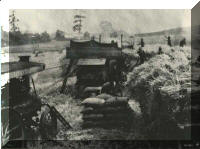
The story of his death was told in the local newspaper:
Cornwall Chronicle Wednesday 14 February 1872
Thrashing Machine Accident at Evandale.
A shocking accident occurred about six o'clock on Saturday last, at Evandale by which a man named John Cocker lost his life. The deceased was employed as a feeder to Mr. Bryant's thrashing machine engaged at Mr. Easton's Cambock and it appeared from the evidence taken at the inquest (which was held at the house of Mr. P. Mullane, Macquarie Hotel before John Ralston, Esq, coroner, and a respectable jury, on the afternoon of Saturday that the deceased had just finished emptying the headings out of some bags into the drum of the machine, and was scraping the loose stuff with his foot, when the men engaged with him were startled by a cry, and looking round saw the deceased in the machine, the belt of the wheel immediately flew off, but not before the left leg of the poor man, as far as the thigh was literally smashed or ground to atoms.
His fellow workmen set to work to extricate him, which occupied about six or seven minutes. He spoke a few words whilst they were so engaged, but after they got him out he never spoke. He died in a few minutes. The only person on the drum of the machine with the deceased was his son, who was engaged cutting the bands and passing them to his father who was feeding. He stated in his evidence that the last bag of headings had just passed through, and his father had thrown him the empty bag. He saw his father scraping the loose straw together.
When he turned round to throw the empty bag on the ground he heard his father cry out, and looking round saw him in the machine, and he called out to stop it. Before the driver could stop it the belt flew off. The son went to assist to take him out, whilst taking him out he said "Don’t; let me alone; I’m all right" He never spoke afterwards. Dr Stewart was examined; and deposed that he saw the deceased immediately after the accident. He was quite dead. He found that the bones of the left leg and the muscles, and also part of the muscles of the thigh were torn off by the machine. He attributed his death to the loss of blood and the shock. On examining the machine, large portions of the flesh and bone were seen. The deceased wore green spectacles at the time of the accident to prevent the wheat striking his eyes.
He had two sons with him at the time - one was engaged in driving the engine and the other in cutting the bands of the sheaves.
Verdict- "Accidental death from injuries received from falling into the drum of a thrashing machine whilst at work." Deceased was a hard-working man, and has left a widow with nine children living at Kentish Plains. A subscription list was opened at Evandale on Saturday night to raise funds for the funeral, and to assist his widow and family, when in a very short time over 12 Pounds was collected.
The full text of his inquest may be read here:
His grave is in the grounds of the Evandale Uniting Church where there is a plaque and seat in his memory. There are also two convict bricks dedicated to him in Campbell Town.
Within three months of his death, Sarah made application for charitable assistance for her four youngest children. Sarah died from a cramped bowel on 30 Aug 1874, aged 46 at the home of her son John at Barrington, two years after the death of her husband and leaving ten children aged between four and 28 years of age.


